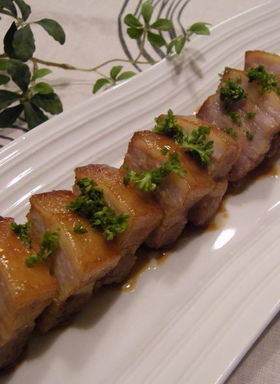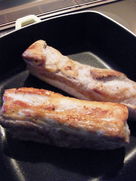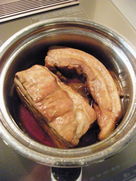
Here the first of a series of recipes for Kakuni, that is a very basic one!
INGREDIENTS: -Large raw pork belly lumps: 1 or 2 (depending on thickness and width)
-Fresh ginger: 1 or 2 pieces (5×5 cm)
-White leek: 1
-Rice vinegar: 50 ml
-Soy sauce: 50 ml
-Sweet sake/mirin: 50 ml
-Honey: 1 tablespoon
-Water: 4–~500 ml
RECIPE:
-Thinly slice the fresh ginger. Cut the leeks into small trunks. Punch holes in the pork with a fork to help “taste going inside”.

-Fry pork on a frypan on all sides on a strong fire until all colour has completely changed and fat has changed colour.

-In a large pot, drop/pour all ingredients, add por, cover with lid and simmer over low medium fire for 60 minutes.
If meat does not cook as quickle as wanted, raise fire after 30 minutes.
Simer until juices have reduced as low as on pic.
-Cut the pork into large size bites and simmer again for 5 minutes.
-Place on a serving meat cuts on a serveing dis. Pour juices/sauce all over and add some chopped thin leeks.
Please check the new postings at:
sake, shochu and sushi
—————————————-
日本語のブログ
—————————————-
this looks simple enough! will try this out this weekend and post about it too! thanks!
LikeLike
Dear Penny!
Greetings!
More to come!
Robert-Gilles
LikeLike
Beautiful!
LikeLike
Cheers, my friend!
More coming!
Robert-Gilles
LikeLike
Found your blog tonite while looking for information on Lonicera -Edbile Blue Honeysuckle. Your blog is very good reading and great pictures. Makes me hungry!
I am wondering if you are in an area where you can grow or do grow the edible honeysuckle.
Clayton
Saskatoon, Canada
LikeLike
Dear Clayton!
Greetings from Shizuoka, Japan!
Honeysuckle in Japanese is called Suikazura/スイカズラ.
There are apparently 20 species in Japan (Lonisera japonica) and 100 in China among the 180 officially known.
They are grown for their flowers in Japan. Apparently accidental wild proliferation of Japanese species in America is creating a problem.
They do produce fruits than can be eaten, although they are avoided in Japan due to the existence of toxic species.
The blue one does seem to exist in Japan!
Hope this has helped you!
If you need any more information, please do buzz me!
Cheers,
Robert-Gilles
LikeLike